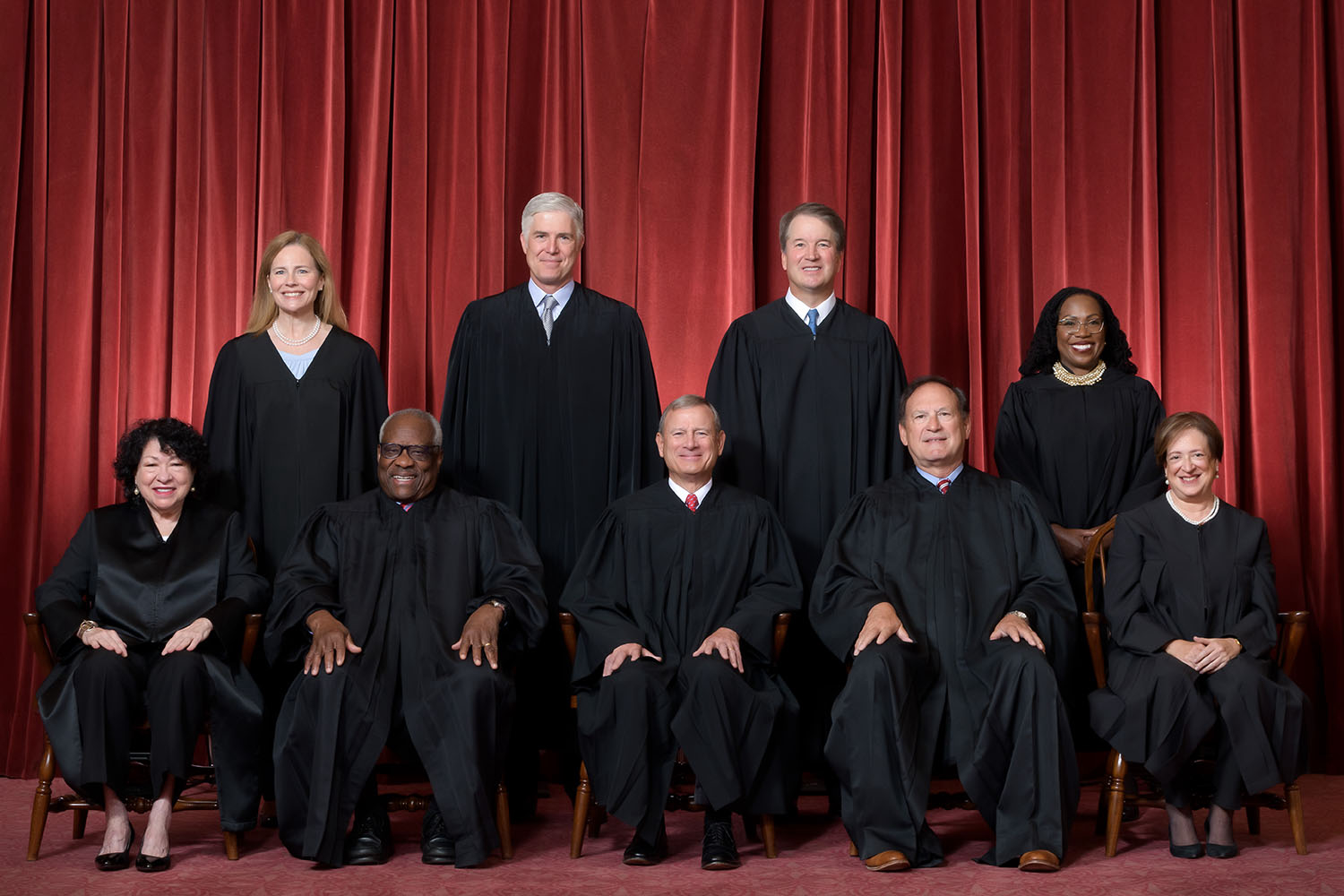Overturning precedent on the Roberts court


In early December, the Supreme Court will hear oral arguments in cases asking the justices to overrule two longstanding precedents – Humphrey’s Executor v. United States, a 1935 decision upholding a federal law that limits the president’s power to fire members of the Federal Trade Commission, and Federal Election Commission v. Colorado Republican Federal Campaign Committee, a 2001 ruling that upheld a major campaign-finance law. Before that, the justices will consider a petition for review from former Kentucky county clerk Kim Davis asking the justices to overturn their 2015 decision recognizing a right to same-sex marriage. Critics have pointed to a long line of precedents that the Roberts court, in their view, has sought to aggressively overturn. But how accurate is that perception – and what is the majority’s basis for overturning precedent in the first place?
In a recent interview with The New York Times, Justice Amy Coney Barrett emphasized that “the Roberts court has overturned precedent roughly one time per year,” compared with the Rehnquist and Burger courts, which “were at around two and a half or three.” In a post at the Volokh Conspiracy, law professor Jonathan Adler made a similar point, writing that “[e]ven though the Court now has a six-justice conservative majority, which should make it easier to overturn precedents at odds with conservative jurisprudential principles, the rate at which the Court is overturning prior precedents has not (yet) increased. To the contrary, it appears to have slowed.”
Adler acknowledged that one reason why the Roberts court has overturned fewer precedents than its predecessors “is that it hears fewer cases.” Indeed, Adam Feldman – a lawyer and political scientist who follows the court closely – reported back in 2022 that the Roberts court averaged just 65.6 majority opinions in argued cases, compared with 94.8 for the Rehnquist court and 131.5 for the Burger court.
And even if the Roberts court has overruled, on average, relatively few precedents, some of the recent cases in which it has done so have been landmark ones, such as Dobbs v. Jackson Women’s Health Organization, in which the court overturned Roe v. Wade, which recognized a constitutional right to an abortion, and Loper Bright Enterprises v. Raimondo, in which the justices struck down the Chevron doctrine, which counseled courts to defer to federal agencies’ interpretation of a statute.
As a general rule, courts apply the doctrine of stare decisis, which literally means “to stand by things decided.” It is the principle that courts should follow their earlier decisions in similar cases – even if they might believe they are wrong – unless there is good reason to do otherwise. The doctrine is intended to promote stability, predictability, a sense of fairness, and public confidence in the courts.
At the same time, the Supreme Court has made clear that stare decisis “is not an inexorable command,” particularly when it comes to the interpretation of the Constitution. “An erroneous constitutional decision can be fixed by amending the Constitution,” Justice Samuel Alito acknowledged in Dobbs, “but our Constitution is notoriously hard to amend.”
In recent decisions that overruled earlier cases, the justices in the majority began their analysis by considering the merits of the question at the center of the dispute. In Dobbs, for example, Alito concluded that “a right to abortion is not deeply rooted in the Nation’s history and traditions. On the contrary, an unbroken tradition of prohibiting abortion on pain of criminal punishment persisted from the earliest days of the common law until 1973.”
In Loper Bright, Chief Justice John Roberts wrote that the Chevron doctrine “defies the command of the” Administrative Procedure Act, the federal law governing administrative agencies, “‘the reviewing court’—not the agency whose action it reviews—is to ‘decide all relevant questions of law’ and ‘interpret . . . statutory provisions.’”
And in another notable decision, Janus v. American Federation of State, County and Municipal Employees, the court overturned Abood v. Detroit Board of Education, a 41-year-old decision holding that government employees who are represented by a union but do not belong to that union can be required to pay a fee to cover the union’s costs to negotiate a contract that applies to all employees. In a 5-4 opinion written by Alito, the majority agreed with the challengers that such “arrangements violate the First Amendment.”
Having concluded that its prior cases were wrong, the court’s analyses then turned to “whether stare decisis nonetheless counsels against overruling” those decisions. The court considered several different factors in reaching decisions like Dobbs, Janus, and Chevron, although the dissenting justices in those cases disagreed with both the majority’s conclusion that the earlier precedents were wrong and its analysis leading to the decision to overturn them.
The extent of the error in the earlier decisions. In Dobbs, Alito compared Roe v. Wade, the 1973 decision establishing a right to an abortion, to the court’s decision in Plessy v. Ferguson, allowing racial segregation when the state provided “separate but equal” facilities, calling it “egregiously wrong and deeply damaging.”
The quality of the reasoning in the earlier decisions. Alito wrote that Roe “was more than just wrong” and in fact “stood on exceptionally weak grounds.” Among other things, he said, the court “failed to ground its decision in text, history, or precedent” and it “relied on an erroneous historical narrative.”
In Loper Bright, Roberts characterized the Chevron doctrine as “fundamentally misguided. Despite reshaping judicial review of agency action, neither it nor any case of ours applying it grappled with the APA—the statute that lays out how such review works.”
In Janus, Alito concluded that Abood v. Detroit Board of Education, the 1977 decision under review in the case, “was poorly reasoned” and misinterpreted prior precedent.
The “workability” of the rules established in the earlier decisions. In Dobbs, Alito described this factor as “whether the rule” an earlier decision “imposes … can be understood and applied in a consistent and predictable manner.” This had not been met in the court’s abortion decisions, Alito suggested, because of the difficulty in applying the tests laid out by the court and the many divisions among the lower courts.
“Experience has also shown that Chevron is unworkable,” Roberts wrote in Loper Bright. He explained that it is too difficult to define what it means for a statute to be ambiguous, which, under Chevron, mandated that the reviewing court defer to an agency’s interpretation of that statute. Moreover, he added, even if a statute may appear to be ambiguous, it “still has a best meaning, necessarily discernible by a court deploying its full interpretive toolkit.”
Alito voiced a similar concern in Janus. Although the court in Abood drew a line between the costs that could and could not be included in the fees charged to workers who did not belong to the union, he wrote, in practice that distinction “has proved to be impossible to draw with precision.”
Subsequent developments. In Janus, Alito contended that “[d]evelopments since Abood, both factual and legal, have … ‘eroded’ the decision’s ‘underpinnings’ and left it an outlier among our First Amendment cases.” For example, he said, when Abood was decided, relatively few people belonged to public-sector unions, but both membership in those unions and their spending had increased markedly since then. “These developments, and the political debate over public spending and debt they have spurred,” Alito wrote, “have given collective-bargaining issues a political valence that Abood did not fully appreciate.”
Alito also described Abood as “an ‘anomaly’ in our First Amendment jurisprudence,” particularly when compared with “cases holding that public employees generally may not be required to support a political party.”
The effect of the earlier decisions on other areas of the law. In Dobbs, Alito suggested that the court’s abortion decisions had had a negative effect on other areas of the law, including by “ignor[ing] the Court’s third-party standing doctrine,” which governs when a litigant may file a lawsuit on behalf of someone else.
Whether and to what extent people or entities relied on the decisions. The court also typically considers “traditional reliance interests.” Alito in Dobbs rejected any suggestion that women had relied on the decisions in Roe and Casey, reasoning that “getting an abortion is generally ‘unplanned activity.’”
Chevron, Roberts said in Loper Bright, has not provided the “sort of ‘stable background rule’ that fosters meaningful reliance” on the rule that it established. Because of the Supreme Court’s “constant tinkering with” the doctrine, as well its eventual abandonment of the doctrine, he wrote, “it instead is hard to see how anyone—Congress included—could reasonably expect a court to rely on Chevron in any particular case.”
And in Janus, Alito rejected the union’s contention that “collective-bargaining agreements now in effect were negotiated with agency fees in mind and that unions may have given up other benefits in exchange for provisions granting them such fees.” “[I]t would be unconscionable,” Alito stated, “to permit free speech rights to be abridged in perpetuity in order to preserve contract provisions that will expire on their own in a few years’ time” – especially, in his view, when the unions have been aware for some time that the court’s decision in Abood could be in jeopardy.
Justice Elena Kagan’s dissent in Janus pushed back, arguing that reliance “demands keeping Abood.” She pointed to laws in 22 states authorizing agency fees, as well as “thousands of current contracts covering millions of workers [that] provide for agency fees.” Such dissents indicate that although a majority of the justices may agree on the factors that they should consider when determining whether to overrule precedent, there is no consensus on how to apply these – and that it is likely to be a point of significant contention in the future.
Posted in Court Analysis, Featured, Merits Cases
Cases: Janus v. American Federation of State, County, and Municipal Employees, Council 31, Dobbs v. Jackson Women’s Health Organization, Loper Bright Enterprises v. Raimondo